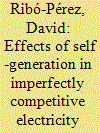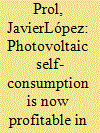|
|
|
Sort Order |
|
|
|
Items / Page
|
|
|
|
|
|
|
| Srl | Item |
| 1 |
ID:
192780


|
|
|
|
|
| Summary/Abstract |
Distributed rooftop photovoltaics (PV) is one of the pillars of the energy transition yet their widespread integration strains grids, leading to over-voltage, reverse power flow, and infrastructure strain. Furthermore, increased PV self-consumption reduces imported electricity, posing challenges for cost recovery by Transmission System Operators (TSOs) and Distribution System Operators (DSOs), whose grid costs were traditionally tied to volumetric tariffs. To investigate whether alternative tariffs could mitigate PV impacts at the distribution level without hampering PV development, we assess five electricity tariffs that could help the DSOs to recover the costs of maintaining the distribution grid. We also analyze their effects on private storage investment and their implications for urban, semi-urban, and rural low-voltage networks. We found that tariffs with a capacity-based component promote further adoption of PV and storage. At the same time, they allow the DSOs to recover the grid cost without incurring relevant economic differences for the customer. Our study found that alternative tariffs like dynamic and capacity-based tariffs promote the adoption of storage and PV systems. While no single tariff alone can fully mitigate PV impacts at the distribution level, our results point towards the need of managing PV export through solutions like PV curtailment.
|
|
|
|
|
|
|
|
|
|
|
|
|
|
|
|
| 2 |
ID:
115667


|
|
|
|
|
| Publication |
2012.
|
| Summary/Abstract |
The profuse dissemination and utilisation of solar PV technology in the world is indispensable, especially in this era of climate change. However, in the African continent, between 1960 and 2007 Kenya and Zimbabwe were among countries with the highest PV dissemination, while Ghana was among countries with the least disseminations. Analysing empirical data through the lens of the Social Construction of Technology (SCOT) theory, the article aims to uncover the drivers underpinning the disparate dissemination trends of PV in the three countries within the stated period and to tease out lessons apropos replicating the successes within Kenya and Zimbabwe in Ghana. SCOT theory is chosen because it provides an excellent framework for analysing the social shaping of PV's development and diffusion processes in these countries. This theory posits that the shape and meanings of a technology do not reside in it, but are acquired through the heterogeneity of social interactions. Findings in the paper reveal that a gamut of socio-economic and political antecedents informed the varied dissemination outcomes of the technology in these countries. Premised on these findings, the paper recommends critical steps, which Ghana needs to undertake to enhance the replication of the Kenyan and Zimbabwean PV success stories.
|
|
|
|
|
|
|
|
|
|
|
|
|
|
|
|
| 3 |
ID:
168654


|
|
|
|
|
| Summary/Abstract |
Domestic rooftop photovoltaic (PV) energy can reduce net electricity demand, and therefore reduce energy prices through a merit-order effect. This reduces profits of all incumbents in the electricity markets. In addition, in imperfectly competitive markets, PV self-generation reduces prices through a reduction in market power. The first effect may warrant additional policy interventions to maintain cost recovery, but the second is much more desirable, as it simultaneously helps increase sustainability and competition. However, unlike a simple reduction in market prices, the competition effect affects all incumbents differently. Since resistance from incumbents can be a significant barrier to energy policy change, it is important to understand the distribution of effects. This paper does so for the Spanish market. A Nash-Cournot model and a simplified representation of the Spanish electricity market is used to determine the merit-order and competition effects of an increase in solar self-generation. We conclude that both are important, and that their analysis is essential to inform the social debate around PV policy.
|
|
|
|
|
|
|
|
|
|
|
|
|
|
|
|
| 4 |
ID:
099317


|
|
|
|
|
| Publication |
2010.
|
| Summary/Abstract |
This paper presents a grid matching analysis of wind energy conversion systems (WECSs) and photovoltaic (PV)-WECS hybrid systems. The study was carried out using hourly load data of the Israel Electric Corporation (IEC) for the year 2006 and the corresponding simulated hourly performance of large PV and WECS plants in the Negev Desert. Our major objective was to compare the grid-matching capabilities of wind with those of our previously published PV results, and to assess the extent to which the combined employment of WECS and PV can improve the grid matching capability of either technology when used on its own. We find that, due to the differences in diurnal and seasonal output profiles of WECS and PV, their tandem employment significantly improves grid penetration compared to their use individually.
|
|
|
|
|
|
|
|
|
|
|
|
|
|
|
|
| 5 |
ID:
166309


|
|
|
|
|
| Summary/Abstract |
Electric power distribution network charges have become a popular area of study for regulators, industry and academia. Increasing use of photovoltaics (PVs) and electric vehicles (EVs) by domestic customers has created concerns about the fairness of the current tariff structure. Proposing a tariff design, which will be cost reflective, transparent, sustainable, economically efficient is socially desirable. Wealth transfer through electricity distribution tariffs is a major concern for energy regulators. This paper aims to analyse the current distribution network tariffs faced by four main household customer groups in Great Britain (GB) - defined as those who own a PV and an EV, those with EV but no PV, those with PV but no EV and finally those with neither EV nor PV – under various uptake scenarios for EVs and PVs. We illustrate the impact on household tariffs for the most and least expensive GB network operators, namely London Power Networks and Scottish Hydro Electric Power Distribution. The results show that, due to the current network charges calculation structure, as PV penetration increases, the distribution tariffs increase for all customers regardless of whether someone owns a PV or not. On the other hand, as EV penetration increases, the distribution tariffs decrease for all customer groups. Another key finding is that the distribution tariffs in Great Britain are EV dominated and the future EV and PV penetration projections indicate that the distribution tariffs will likely decrease for all customers in Great Britain.
|
|
|
|
|
|
|
|
|
|
|
|
|
|
|
|
| 6 |
ID:
191279


|
|
|
|
|
| Summary/Abstract |
Decarbonizing urban energy consumption is critical for addressing climate change, yet renewable power installations in cities are rare due to limited space and economic unattractiveness. Community solar, where multiple electricity users share the electricity generated by their rooftop PV systems, could help overcome these barriers and accelerate PV adoption in cities. Using an agent-based model, we simulated the decision-making of nearly 5000 building owners in a city district in Zurich, Switzerland, and assessed three locally relevant policy scenarios: no community solar, community solar with adjacent buildings, and community solar with buildings within a 100-meter radius. The results show that allowing community solar with adjacent buildings increases the installed PV capacity in 2035 by 1%, as greater economies of scale and higher self-consumption make PV adoption more economically attractive. A more permissive policy, allowing community solar with buildings within a 100-meter radius, provides more opportunities to communities to grow over time and results in 21% more PV installed capacity in 2035 than without community solar. These findings demonstrate the potential of community solar to accelerate PV adoption in cities and underscore the significant role of policy design in achieving this goal.
|
|
|
|
|
|
|
|
|
|
|
|
|
|
|
|
| 7 |
ID:
175264


|
|
|
|
|
| Summary/Abstract |
Whereas Spain used to have one of the most restrictive photovoltaic self-consumption (PVSC) regulations in the world, the new regulation (RD-L 15/2018 & RD 244/2019) improves the economic conditions of PVSC systems, simplifies administrative procedures and allows shared self-consumption. We analyze the impact of the new PVSC regulation on residential, commercial and industrial prosumers’ profitability (internal rate of return). We provide a wide range of results that allow us to explore future profitability depending on the evolution of installation costs, the opportunities of shared self-consumption or storage, and even the potential emergence of new business models. We find that all segments obtain now positive profitability in average conditions. Whereas the residential segment has the lowest profitability level, it has the highest potential by decreasing installation costs and increasing the share of self-consumption, given its higher retail prices. Finally, we identify potential new business models by exploiting the prices and costs differentials across segments and maximizing the share of self-consumed electricity. PVSC systems with industrial costs exploiting residential markets could achieve 35% profitability by reaching 75% self-consumption, and even higher than 40% when self-consumption exceeds 85%.
|
|
|
|
|
|
|
|
|
|
|
|
|
|
|
|
| 8 |
ID:
169722


|
|
|
|
|
| Summary/Abstract |
Falling costs of solar PV and battery technologies are continuously changing the customer relationship with their electricity network. By managing their own self-generation, customers are able to place natural selection pressure on utilities to evolve. The devised techno-economic simulation model projects residential PV and battery investment decisions over 20 years in Perth, Australia to quantify the potential market impacts from policy and customer investment conditions. Using real-world demand and insolation profiles from 261 households, this research evaluates how cumulative customer PV and battery investments changes the network and market operating conditions, while under the influence of various feed-in tariff values. The results indicate that high feed-in tariff policy costs in the short-term, make it economically challenging to prevent or restrain significant residential PV-battery adoption in the longer-term. Moreover, continuous increases in residential PV-battery system installations eventually lead to annual net-exports substantially exceeding net-imports on the distribution network. This significant shift in network operation provides an opportunity for policymakers to utilise behind-the-meter PV-battery investments and decentralised energy markets to meet wider renewable energy and decarbonisation goals.
|
|
|
|
|
|
|
|
|
|
|
|
|
|
|
|
| 9 |
ID:
169760


|
|
|
|
|
| Summary/Abstract |
Due to significant cost advantages, wind energy penetrated the energy mix of most large countries much faster than solar PV did until the recent decade. However, Japan has been almost one-sidedly leaning toward the more expensive solar PV. For using solar PV electricity, the Japanese consumers are also paying sizably higher tariffs than those in other countries, especially after the Fukushima nuclear accident in 2011 that led to the sudden suspension of all nuclear power plants. Japan's energy transition towards renewables is accordingly largely single legged, rather than more balanced to take advantage of both wind turbines and solar PV. This article explains the puzzle on why renewable energy development in Japan has created such a wide distance from more economically optimal situations. We focus on the initiation, formation and impacts of the solar lobby that comprises bureaucracies, politicians, solar PV manufacturers, and independent power producers. Policy implications are drawn for Japan and other countries on the importance of controlling political lobby to achieve less costly energy transition.
|
|
|
|
|
|
|
|
|
|
|
|
|
|
|
|
|
|
|
|
|